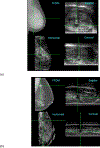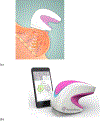Novel imaging approaches to screen for breast cancer: Recent advances and future prospects
- PMID: 31554573
- PMCID: PMC6764602
- DOI: 10.1016/j.medengphy.2019.09.001
Novel imaging approaches to screen for breast cancer: Recent advances and future prospects
Abstract
Aim of the study: Over the past 50 years, the application of mammography - an X-ray of the breast - to screen healthy women has been a successful strategy to reduce breast cancer mortality. The aim of this study was to review the literature on novel imaging approaches that have the potential to replace mammography.
Methods: An online literature search was carried out using PubMed, Google Scholar, ScienceDirect and Google Patents. The search keywords included "breast cancer", "imaging" and "screening", with 51 journal articles and five United States patents being selected for review. Seventeen relevant online sources were also identified and referenced.
Results: In addition to full-field digital mammography (FFDM), a further nine imaging modalities were identified for review. These included: digital breast tomosynthesis (DBT); breast computed tomography (BCT); automated breast ultrasound (ABUS); fusion of FFDM and ABUS; fusion of DBT and ABUS; magnetic resonance imaging (MRI); optical imaging; radio-wave imaging; and tactile sensor imaging. Important parameters were considered: diagnostic success (sensitivity and specificity), especially in dense breasts; time to acquire the images; and capital cost of the equipment.
Conclusions: DBT is rapidly replacing FFDM although it still misses invasive cancers in dense tissue. The fusion of ABUS, either with FFDM or DBT, will lead to sensitivity and specificity approaching 100%. The fusion of opto-acoustic imaging with ultrasound holds considerable promise for the future.
Keywords: Breast cancer; Dense breast tissue; Imaging; Screening.
Copyright © 2019. Published by Elsevier Ltd.
Conflict of interest statement
Competing interests
I am an employee of, and a board member and shareholder in CapeRay Medical (Pty) Ltd, a company whose product called Aceso is described in this review paper.
CLV is a board member and shareholder in CapeRay.
Figures













References
-
- Egan RL, “Experience with mammography in a tumor institution. Evaluation of 1,000 studies”, Radiology, 75: 894–900, 1960. - PubMed
-
- Larsson LG, Nyström L, Wall S, Rutqvist L, Andersson I, Bjurstam N, Fagerberg G, Frisell J, Tabár L, “The Swedish randomised mammography screening trials: analysis of their effect on the breast cancer related excess mortality”, Journal of Medical Screening, 3(3) :129–132, 1996. - PubMed
-
- Hendrick RE, Smith RA, Rutledge JH, Smart CR, “Benefit of screening mammography in women aged 40–49: a new meta-analysis of randomized controlled trials”, Journal of the National Cancer Institute Monographs, 22: 87–92, 1997. - PubMed
-
- Pisano ED, “Current status of full-field digital mammography”, Radiology, 214: 26–28, 2000. - PubMed
-
- Kopans DB, “Breast cancer screening: Where have we been and where are we going? A personal perspective based on history, data and experience”, Clinical Imaging, 50: 91–95, 2018. - PubMed
Publication types
MeSH terms
Grants and funding
LinkOut - more resources
Full Text Sources
Medical
Research Materials
Miscellaneous

